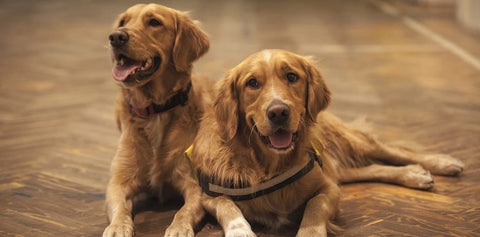

Common dog illnesses and health issues
We all want our dogs to stay healthy, but even with the best care, common dog illnesses can sometimes crop up.
Some issues are easy to spot, while others appear with subtle signs. Knowing what to look for can make all the difference.
This guide covers some of the common dog ailments, their causes, and how to prevent them. Understanding the facts is key, whether you have a playful puppy or a senior dog. It helps keep them happy and healthy.
Most common dog health issues and illnesses
As dog owners, keeping our pets healthy is a top priority. Dogs bring us joy, but they can face health challenges. Here are the top 10 health issues affecting dogs today, based on a recent study:
- Gum disease (12.5%) Plaque build-up causes pain, tooth loss, and bad breath
- Ear infections (7.3%) Bacteria or allergies can lead to head shaking and discharge
- Obesity (7.1%) Excess weight stresses joints and raises disease risk
- Overgrown nails (5.5%) Long nails cause discomfort and mobility issues
- Anal sac impaction (4.8%) Scooting and licking signal blocked anal sacs
- Diarrhoea (3.8%) Often from diet changes, scavenging or infections; watch for dehydration
- Vomiting (3.1%) Can be mild or a sign of illness needing vet care
- Lameness (2.7%) Limping or stiffness may signal injury or arthritis
- Arthritis (2.3%) Joint pain and reduced movement, increasingly prevalent in older dogs.
-
Skin issues and allergies Redness, itching, or flaky skin from allergies or parasites
|
Health topic |
Common issues |
Possible causes |
Treatment & support |
Jump to |
Find out more |
|
Dental |
Gum disease. Tooth decay and fractures. Tartar build-up. |
Plaque build-up.
|
Regular cleaning and brushing at home. Dental vet check-ups. |
Dental issues in dogs |
Silent signs of dental discomfort in dogs
Is your dog prone to poor dental health?
|
|
Skin issues and allergies |
Parasitic infections (including flea allergies and mange) |
Flea bites. Pollen, grass, mould or cleaning products. Certain proteins or carbohydrate sources, wheat grain and soy. Additives. Mite bites. |
Flea treatment. Paw wipes. Sensitive shampoo. Dietary changes – speak to your vet. Supplement support. Medication. |
Skin issues & allergies in dogs |
|
|
Digestion |
Diarrhoea and vomiting. Food intolerance. |
Sudden food changes. Infections - bacteria and viruses. Eating something that disagrees with them or something they shouldn’t. Intolerance to certain foods. Fatty foods.
|
Dietary changes. Medication. Supplement support. Vet-approved diet.
|
Stomach, digestion and diet issues in dogs |
How to help your dog’s sensitive stomach
Stomach problems in dogs: Symptoms, causes and treatments
How to support your dog’s digestion
|
|
Joints |
Arthritis. Hip and elbow dysplasia. Stiffness and slowing down. |
Muscle loss. Ageing. Illness. |
Medication. Exercise and weight control. Physiotherapy. Supplement support. Surgery.
|
Joint & musculoskeletal issues in dogs |
Stiff joints in dogs: why your dog's joints hurt & caring for them
How to help a dog with arthritis at home
|
|
Eyes, ears and nails |
Infections. Sight loss. Cataracts. Conjunctivitis. Dry eyes. Long nails. Ingrown nails. |
Infections caused by bacteria, yeast, or allergies. Ageing. Irregular cutting. |
Medication. Supplement support. Regular trimming.
|
Other common physical issues in dogs |
When and how to clean your dog's ears
How to take care of your dog’s eyes
|
About dog health issues
Now that we've covered the top 10 dog diseases, let’s dive deeper. Each section covers causes, symptoms and treatments. We’ll start with dog dental health.
Dental issues in dogs
Dog oral health plays a big role in overall wellbeing. Yet many owners don’t realise there's a problem until it becomes painful or advanced. Here are the most common dental issues in dogs and how to manage them.
Gum disease Also called Gingival Disease, this is one of the most common dog illnesses. Plaque builds up first. It can lead to sore gums, tooth loss, and infections that spread beyond the mouth. Signs include bad breath, red gums, and trouble eating.
Regular brushing and dental check-ups help prevent it.
Tooth decay and fractures Dogs can crack teeth by chewing hard toys, stones, or bones. Decay may also set in if plaque isn’t removed. Watch for signs like drooling, chewing on one side, or avoiding food. Treatment may mean tooth removal or repair by a vet.
Tartar build-up If plaque isn’t cleaned away, it hardens into tartar. This sits on the teeth and under the gums causing irritation and infection. A vet may need to carry out a professional clean under anaesthetic.
Retained baby teeth In some breeds, baby teeth don’t fall out as they should. This can lead to crowding, decay and discomfort. Common in small breeds, extraction under general anesthetic may be needed.
For more on healthy dog teeth, visit our guide: How healthy are your dog’s teeth. You can also read our article on Do dogs get tooth pain? for signs to watch for and how to help.

Skin issues & allergies in dogs
Dogs often have skin allergies, but the signs aren’t always clear. Pests, diet and more can cause skin issues. The good news? Many problems can be managed or prevented once you know the cause.


